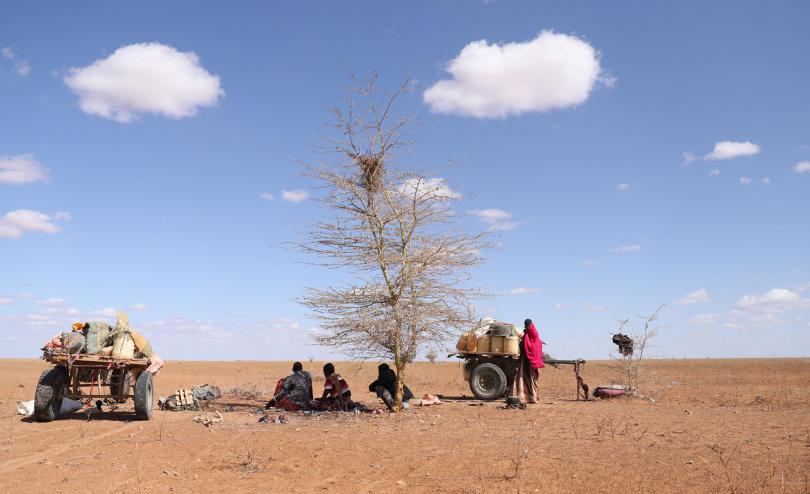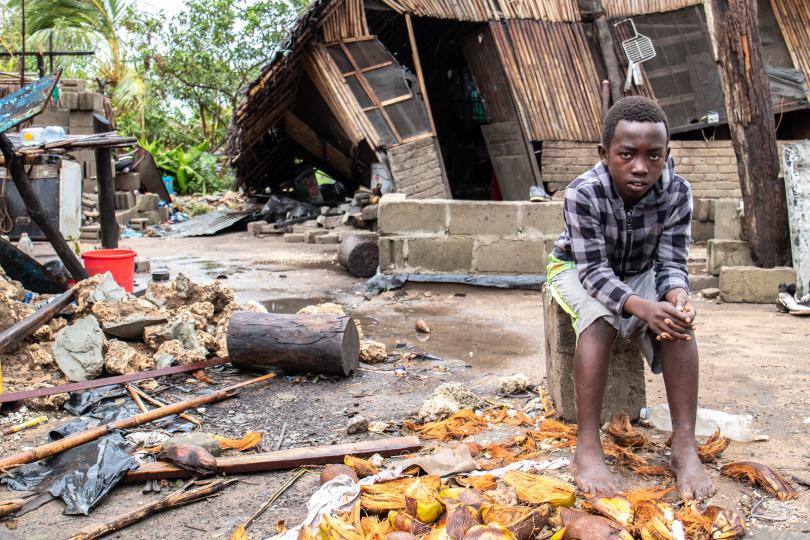2019: Climate shocks claim more than 1200 lives across East and Southern Africa

- The climate crisis contributes to at least 33 million people in the region – or 10% of the population across ten countries – being at emergency levels of food insecurity or worse1. Over 16 million are believed to be children2.
- New analysis from Save the Children shows over 1200 people lost their lives as the result of cyclones, floods and landslides in Mozambique, Somalia, Kenya, Sudan and Malawi3.
- Southern Africa is warming at twice the global rate4 and many countries have been buffeted by multiple shocks, including Mozambique experiencing two strong cyclones in the same season for the first time in recorded history.
- As world leaders meet this week at the 25th United Nations Climate Change Conference (COP 25), Save the Children calls on them to commit to greater action to reduce the impact of the climate crisis on children, in East and Southern Africa and globally, who will be living with the impact of their decisions.
2019 will be remembered as the year the climate crisis devastated parts of east and southern Africa, with floods, landslides, drought and cyclones leaving at least 33 million people at emergency levels of food insecurity or worse, according to new analysis by Save the Children.
A recent UN Intergovernmental Panel on Climate Change (IPCC) report shows increasing evidence that climate change is contributing to higher temperatures in the region, and that these temperatures are exacerbating the impacts of drought and flooding5. These climate shocks decimate livelihoods, leaving households desperate for food and putting children at risk of acute malnutrition - a life threatening condition requiring urgent treatment. Children also bear close to 90 per cent of the burden of disease attributable to climate change, such as malaria and dengue fever6.
Repeated erratic and extreme weather events in east and southern Africa has meant that in 2019:
- At least 1,200 people lost their lives as the result of cyclones, floods and landslides in Mozambique, Somalia, Kenya, Sudan and Malawi7. This figure does not include the thousands of lives lost to drought, and Save the Children fears that soaring hunger levels over the past 12 months will have contributed to further loss of life as well as malnutrition, particularly amongst infants.
- Ten countries across East and Southern Africa - Madagascar, Malawi, Mozambique, Zambia, Zimbabwe, South Sudan, Sudan, Ethiopia, Somalia and Kenya – are experiencing an ongoing weather-induced crises, with an average of 10% of people living in these countries currently experiencing serious hunger8. With high populations of children – a total of 162 million under 18 year-olds across the ten countries - Save the Children estimates these figures include over 16 million children now at crisis or emergency levels of hunger9.
- Massive movements of people have created additional risks of children being exploited, separated from their families, or dropping out of school. By June 201910, over 1 million people across seven of the ten countries had been newly displaced by climate-related shocks11. Over half of these displacements were the result of Cyclone Idai, which hit Mozambique, Zimbabwe and Malawi in March 2019, and was followed six weeks later by Cyclone Kenneth, which was the first time in Mozambique’s recorded history of two strong tropical cyclones in the same season. The storms were also the strongest cyclones ever to hit the African continent12.
In October 2019, the Shebelle River in Somalia broke its banks, flooding the town of Beledweyne, home to nearly 400,000 people.

In Mozambique, an unprecedented two cyclones in six weeks left 502,000 people displaced and 1.6 million people severely food insecure.
By June 2019, the number of people forced to flee their homes as a result of climate shocks in the region was already the same as for the whole of 201813, and does not count more recent displacements from floods which have struck Somalia, Ethiopia, Kenya, South Sudan and Sudan over the past three months. These disasters have currently displaced at least an additional 1.1 million people14, compared to 1021600 at the end of 2018. Based on the current trajectory, this figure could double by the end of 2019.
Save the Children is urging the international community to take greater steps to tackle the climate crisis and its impact on children around the world, which is vital for achieving the Sustainable Development Goals, the 2030 Agenda Pledge to Leave No One Behind and ultimately the rights of all children as outlined in the UN Convention on the Rights of the Child. As part of this, the international community needs to work with governments in east and southern Africa and across the globe to support the development and implementation of national action plans on climate change.
Amran is a 13 year old girl whose home was flooded when the banks of the Shabelle River broke in Beledweyne, Somalia. Amran is now living in a tent with her parents and three siblings. Amran said:
I was very horrified when I heard the water is coming and will be reaching our house. I did not know what would happen to me and my family. We were all very scared.
Save the Children’s Regional Director for East and Southern Africa, Ian Vale, said:
The findings of this analysis are grim, and show that the climate crisis is further entrenching inequality, poverty and displacement across East and Southern Africa. The climate crisis is happening here, it’s killing people, it’s forcing them from their homes, and it’s ruining children’s chance of a future.
With these overlapping, unrelenting emergencies, the humanitarian system is also being stretched to breaking point. Repeated cycles of food insecurity from climate-related shocks is resulting in significant funding shortfalls and unmet humanitarian needs. We are reaching a crisis point in this region.
As world leaders come together for COP25, we call on them to take strong decisions to reduce the impact of climate change and ensure the lives and futures of our children is protected. We call on donors to increase and sustain funding for humanitarian assistance across East and Southern Africa, with initiatives linked to existing measures to increase children's protection, access to health and education, and livelihood support. And most importantly, children need to be actively involved in international, national and local efforts to mitigate the effects of climate change.
Save the Children is the global leader in protecting children in emergencies and natural disasters, working with communities to set up evacuation routes, pre-position emergency supplies, fight against the effects of drought, and access clean water.
For more information and to arrange interviews, please contact:
- Rik Goverde in London: rik.goverde@savethechildren.org / +44 (0) 7732 602 301
- Daphnee Cook in Nairobi [excluding 29 November – 3 December]: daphnee.cook@savethechildren.org / +254 717 524 904
- During out of office hours: media@savethechildren.org.uk / +44 7831 650409
NOTES TO EDITORS
Photos and case studies are available here
[1] In South Sudan, 6.35 million people (54% of the population); Zimbabwe, 3.58 million people (25% of the population); Sudan, 5.8 million people (14% of the total population); Somalia, 2.1 million people (14% of the population); Zambia, 2.3 million people (13% of the population); Ethiopia, 6.7 million people (6% of the population); Malawi, 1.12 million people (6% of the population); Kenya 3.1 million people (6% of the population); Mozambique, 1.6 million people (5% of the population); Madagascar, 916,201 people (3% of the population) are experiencing Crisis or worse levels of food insecurity (IPC Phase 3 and above).
[2] 10% of total under 18 population of the 10 countries [162,370,000]; population data from UNICEF population statistics – under 18 demographics and the World Bank
[3] A total of 1,272 deaths were found in publicly available data from 2019 which are the direct result of floods, landslides and cyclones in east and southern Africa: Mozambique 648 deaths; Zimbabwe 339 deaths; Kenya 95 deaths [source, source and source]; Sudan 78 deaths; Malawi 60 deaths; Ethiopia 30 deaths [source and source] Somalia 22 deaths;
[4] IPCC SPECIAL REPORT Global Warming of 1.5°C pg. 260 states temperatures have been rising in the subtropical regions of southern Africa at approximately twice the global rate over the last five decades (Engelbrecht et al., 2015).
[5] As per [4] pg. 197 Box 3.1 Sub-Saharan Africa: Changes in Temperature and Precipitation Extremes.
[6] UNICEF – Children, Environment and Climate change
[7] As per [3]
[8] 33,566,000 people at IPC 3+, of total 334,096,000 people living in the 10 countries
[9] As per [2]
[10] Latest cross-regional figures available from Internal Displacement Monitoring Centre (IDMC) Mid-year figures January 2019 – June 2019. Half-year data available for Somalia, Ethiopia, South Sudan, Mozambique, Sudan, Malawi and Zimbabwe only. All figures on page 4.
[11] A total of 1,023,000 displacements between January and June for Somalia, Ethiopia, South Sudan, Mozambique, Sudan, Malawi and Zimbabwe only, per [10] page 4.
[12] https://www.newscientist.com/article/2200925-cyclone-kenneth-is-one-of-the-strongest-storms-to-hit-mainland-africa ; https://theconversation.com/why-the-indian-ocean-is-spawning-strong-and-deadly-tropical-cyclones-116559
[13] 1,021,600 total IDPs across the seven of the ten countries as a result of non-conflict disasters in 2018 [Internal Displacement Monitoring Centre (IDMC) 2018 Report]
[14] Based on estimates of most recent UN IDP figures for South Sudan, Sudan, Somalia, Ethiopia and Kenya




